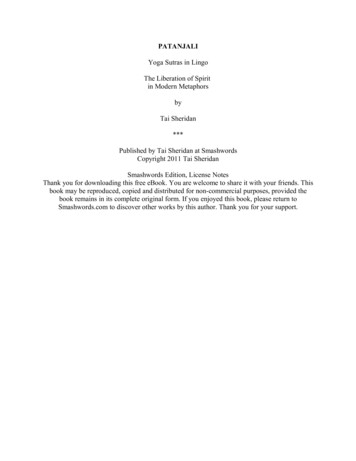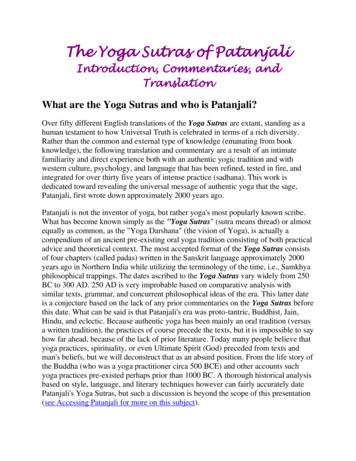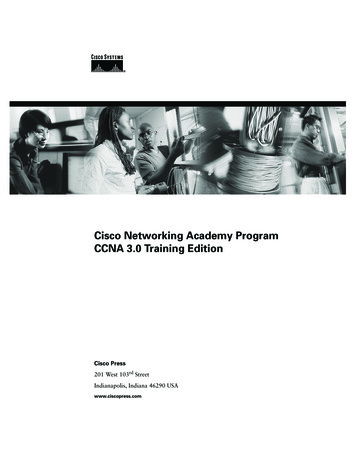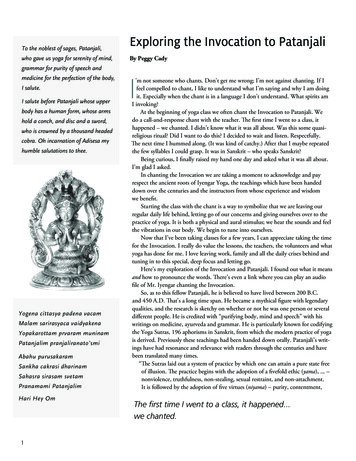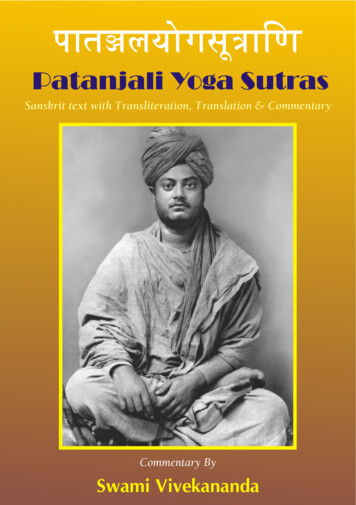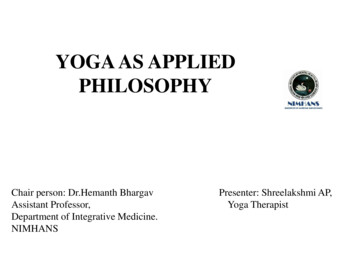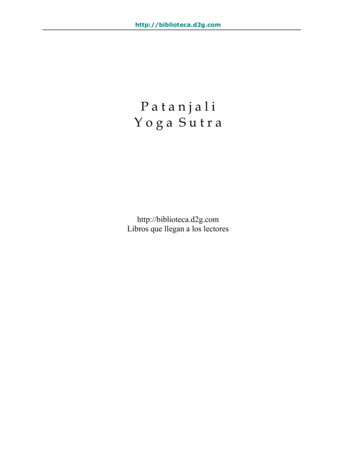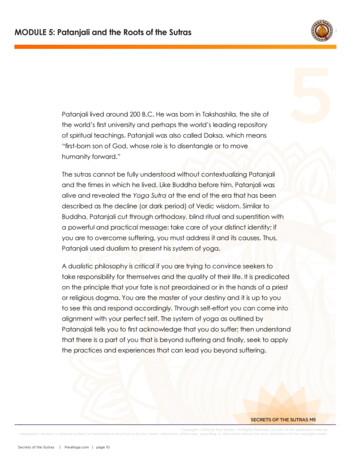
Transcription
MODULE 5: Patanjali and the Roots of the SutrasPatanjali lived around 200 B.C. He was born in Takshashila, the site ofthe world’s first university and perhaps the world’s leading repositoryof spiritual teachings. Patanjali was also called Daksa, which means5“first-born son of God, whose role is to disentangle or to movehumanity forward.”The sutras cannot be fully understood without contextualizing Patanjaliand the times in which he lived. Like Buddha before him, Patanjali wasalive and revealed the Yoga Sutra at the end of the era that has beendescribed as the decline (or dark period) of Vedic wisdom. Similar toBuddha, Patanjali cut through orthodoxy, blind ritual and superstition witha powerful and practical message: take care of your distinct identity; ifyou are to overcome suffering, you must address it and its causes. Thus,Patanjali used dualism to present his system of yoga.A dualistic philosophy is critical if you are trying to convince seekers totake responsibility for themselves and the quality of their life. It is predicatedon the principle that your fate is not preordained or in the hands of a priestor religious dogma. You are the master of your destiny and it is up to youto see this and respond accordingly. Through self-effort you can come intoalignment with your perfect self. The system of yoga as outlined byPatanajali tells you to first acknowledge that you do suffer; then understandthat there is a part of you that is beyond suffering and finally, seek to applythe practices and experiences that can lead you beyond Copyright 2016 by Rod Stryker, All Rights Reserved. No part of this publication may bereproduced, stored in a retrieval system, or transmitted in any form or by any means (electronic, photocopy, recording, or otherwise) without the prior premission of the copyright owner.Secrets of the Sutras ParaYoga.com page 10
5Samkhya is the philosophical blueprint for the sutras.Its distinctive features are:ldualism, distinguishing between prakriti(nature––that which is always changing)and purusha (consciousness––that whichis pure, unchanging, essential, immortal)ldistinct as a spiritual system, Samkhya doesnot rely on a belief in ght 2016 by Rod Stryker, All Rights Reserved. No part of this publication may bereproduced, stored in a retrieval system, or transmitted in any form or by any means (electronic, photocopy, recording, or otherwise) without the prior premission of the copyright owner.Secrets of the Sutras ParaYoga.com page 11
1000 B.C.Upanishadic PeriodBeginning ofJainism Period700 B.C.300 B.C.Decline/Dark Period of Vedic WisdomBrahmana Period of Ritual OrthodoxyTimeline of the Vedas, Sutra and Tantra1,200 B.C.2000 B.C.Pre-Vedic Pre-Tantric Beginning ofVedic PeriodSaraswati CultureBuddha6-5th B.C.Patanjali2 B.C.Sankara8th C. E.Tantric Period15th C. E.SECRETS OF THE SUTRASCopyright 2016 by Rod Stryker, All Rights Reserved. No part of this publication may bereproduced, stored in a retrieval system, or transmitted in any form or by any means (electronic, photocopy, recording, or otherwise) without the prior premission of the copyright owner.ParaYoga.com page 12 Secrets of the Sutras
Invocation to Patanjali5Yógena cittasya padená vacāṃmáláṃ sárīrásya ca vaidyákeṇaYópākarottaṃ pravaraṃ munīnāṃ pátánjálīṃprānjalirāná tosmīÁbāhu purusākāraṃ sankhacakrāsí dhāriṇamsáhásrasirasáṃ svetaṃ práṇámami pátanjalimSrī mate anantāyá nāgarājaya namo namaḥI pray to Patanjali, heir of the great sages, who gave us the knowledge ofAyurveda to remove impurities of the body, Sanskrit grammar to removeimpurities of speech, and Yoga to remove impurities of the mind.I bow completely to Patanjali, who, with a thousand heads and a pure whitecomplexion above his shoulders, a human body below, carries a conch, adisc and a sword.I pay homage and bow perpetually to the serpent king, Adisesha.SECRETS OF THE SUTRAS M5Copyright 2016 by Rod Stryker, All Rights Reserved. No part of this publication may bereproduced, stored in a retrieval system, or transmitted in any form or by any means (electronic, photocopy, recording, or otherwise) without the prior premission of the copyright owner.Secrets of the Sutras ParaYoga.com page 13
MODULE 6: Practice, It’s All About Practice (Sutras 1:1 - 1:11)The first word of the Sutra is atha meaning “auspicious beginning.”Above all else, the Yoga Sutra is a system of practice. The last wordsof the text, chiti shaktih and iti, refers to the ever-awakened power6of consciousness (chiti shakti) that is our final destination (iti). The singlemost vital preparation is having a teacher. A teacher is necessary tocomment and elaborate on the teachings and give insight to thetext’s critical details.Yoga is not necessarily about learning to restrain the forces of mind. It isa means to calm the “mind’s tendency toward restlessness” (vritti “toroam,” “to spin”). The intention of stopping its movement is to make itpossible to attend to the present moment as well as to unveil yourinner luminosity. In order to overcome the restlessness of the mind, you’llutilize not just your mind. You’ll combine asana, pranayama, relaxation,concentration and meditation.Sutra 1:3 tells us that our essential nature (svarupa) is only revealed to a stillmind. Soul is pure and divine, never subject to change. When awareness ofit is mixed with disturbances within the mind (or spinning), the soul loses itsself-awareness. On the other hand, once your self-luminous essence shinesforth, you see that it lights all of life.When you are not resting in your true nature, you are identified withthought, agitation and disturbance, in which case your mind roams fromobject to object. Whereas a one-pointed, inwardly focused mind isillumined by the eternal light residing within you.SECRETSOF THEM1SUTRASM6SUTRAS& M2Copyright 2016 by Rod Stryker, All Rights Reserved. No part of this publication may bereproduced, stored in a retrieval system, or transmitted in any form or by any means (electronic, photocopy, recording, or otherwise) without the prior premission of the copyright owner.Secrets of the Sutras ParaYoga.com page 14
6The key to gaining access to the luminous guiding intelligence––thepower of consciousness (chiti shakti)––is mastery of mind. To access it,you must overcome the mind’s roaming tendencies. These are the fivestates of mind, the first three of which must be overcome if you areto achieve the state of yoga:lkshipta – disturbed, chaotic, no control of the mind, i.e.schizophrenia, psychosislmudha – stupefied, prevents us from being focused oraccessing the higher nature of mind; people who arehighly emotional fall into this category where their moodsovershadow their objectivitylvikshipta – distracted, restless, diffused; this is the mental stateof most yoga seekers; the mind has desires for achieving itshigher capacities but is restless, unable to sustainone-pointednesslekagrata – one pointed; this is a still-present-moment-awaremind capable of steadiness and claritylnirodha – no more mental spinning, the pristine luminousqualities are revealed; in this state you are free; the seekerand sought are oneYoga is the process of moving from distraction to one-pointednessto freedom. To achieve it, you must engage your power of will anddetermination (sankalpa shakti).SECRETSOF THESUTRASM1SUTRAS& M2 M6Copyright 2016 by Rod Stryker, All Rights Reserved. No part of this publication may bereproduced, stored in a retrieval system, or transmitted in any form or by any means (electronic, photocopy, recording, or otherwise) without the prior premission of the copyright owner.Secrets of the Sutras ParaYoga.com page 15
MODULE 7: The Two-Fold Path to Spiritual Mastery (Sutras 1:12 - 1:16)Two terms, abhyasa (“practice”) and vairagya (“non-attachment”)are introduced and defined. In these sutras, practice involves atwo-part process of one, turning away from the external, material,7objective world and two, turning inward, focusing the mind andtraining it to rest in the inner world. The point of practice is to createpositive/constructive impressions (samskara).This is how you form new, spiritually enlivened thoughts and thoughtpatterns; your negative thought habits are gradually replaced by new,inspired and elevated ones.Vyasa expands on the idea of practice, telling us that practice is theendeavor to stay “there.” “There,” he indicates, is sthiti, which he definesas the “continuity of mind devoid of all fluctuations or undisturbedcalmness.” Sthiti is not a goal or object. It is the mind’s essential nature,in which you will learn to be established. From this state all things areaccessible and without it, nothing is. Thus, practice is the effort to remainestablished in the continuity of tranquility.If practice is going to deliver you to this stated goal, it must be done fora long time, without interruption and done with love/reverence.Sutras 1:15 and 1:16 describe nonattachment (vairagya), which means“without coloring,” “detachment,” “renunciation” or “to be free ofcraving.” The perfect embodiment of vairagya occurs when any or allSECRETSOF THEM1SUTRASM7SUTRAS& M2Copyright 2016 by Rod Stryker, All Rights Reserved. No part of this publication may bereproduced, stored in a retrieval system, or transmitted in any form or by any means (electronic, photocopy, recording, or otherwise) without the prior premission of the copyright owner.Secrets of the Sutras ParaYoga.com page 16
7things stop having meaningful, constructive value. Vairagya leadsto recognition of those things that bind you. Vyasa on vairagya:“Anything that contributes to the confusion of our mind should notbe honored, for only a clear mind can help us see the light.” Inother words, if something is causing the mind to spin, we must applynon-attachment to it in order to overcome it and rediscover truth.The Steps of Detachment:lyatamana – understanding and acknowledgement; payattention to your thoughts, speech, and actions; discoveryour role in the world; ask yourself these questions: “Whatam I attached to?” “Why am I attached to it?” “How doesit serve me?”lvryatireka – the processes to eliminate these forces; couldbe a variety of practices; isolate the habits and attenuatethose habits (practice)lekendriya – purify the one sense that got you there – oneof the five senses; work with this sensory awareness in orderto be free; meditate on that sense until you realize it is nolonger pulling you and creating disturbancelvasikara – dispassion, sense of freedom, no longer wantingliberation; this enables you to be a master of yourself, to befree from the dictates of even religion and spiritualityThe highest form of vairagya is the non-attachment that arises fromrecognizing your highest nature. At this stage, the invisible forces of thegunas no longer affect you. In time, as you experience that which isbeyond the gunas, you are less and less pulled by them.SECRETSOF THESUTRASM1SUTRAS& M2 M7Copyright 2016 by Rod Stryker, All Rights Reserved. No part of this publication may bereproduced, stored in a retrieval system, or transmitted in any form or by any means (electronic, photocopy, recording, or otherwise) without the prior premission of the copyright owner.Secrets of the Sutras ParaYoga.com page 17
MODULE 8: The Path to Samadhi (Sutras 1:17 - 1:22)8Sutra 1:17 tells us that all objects known to the mind can beclassified into four categories:lphysicallmental objects, ideas/thoughtslthe inherent joy that is found as we accessthe reservoir of sense-pleasurelthe pure sense of I-am-nessDepending on which of these objects you use in your meditation, you havethe possibility to reach varying levels of samadhi. These are the levels inorder, from lowest to highest:lthe first level is vitarka (“perceptible object” or “to reason”),in which your concentration on a material object reveals aclear sense of yourselflthe second level is vichara (“to reflect or contemplate”),where you meditate on a kind of thought or feeling; this willhave the effect of pulling you to other thoughts ormental ideaslthe third level is ananda (“joy,” “bliss”), which is reached bymeditating on the inherent feeling of joy behind yourthoughts; this is the pleasure that is constant, not externallydependent; its affect creates future disturbance bygerminating more desires for other forms of blissSECRETSOF THEM1SUTRASM8SUTRAS& M2Copyright 2016 by Rod Stryker, All Rights Reserved. No part of this publication may bereproduced, stored in a retrieval system, or transmitted in any form or by any means (electronic, photocopy, recording, or otherwise) without the prior premission of the copyright owner.Secrets of the Sutras ParaYoga.com page 18
l8the fourth level is asmita (“egoism”), which isaccessed by meditating on the pure sense ofI-am-ness; ultimate absorption of this type leadsto involuntary spinning of the mind as it searchesfor the sense of I-am-ness in other objectsThe teaching is making the point that while all of these levels areprofound, there is a necessarily associative mental “spinning” ineach of them. There is still much deepening to do before one canachieve the highest levels of samadhi.In the highest state of samadhi (“spiritual absorption”) the yogi’sawareness (of the object, the process of meditation and the self as thesource of meditation) is left behind. This opens the gate to ultimate freedomand power. You now rest in a world and quality of being that is beyondtime, space and causation.Sutra 1:21 tells us that success on this path comes to those who exerciseintense desire. This emphasizes the necessity of intentionality to attain victoryover the mind. The lowest level of desire is little more than curiosity. Theintermediate level is more intentional, but invariably obstacles will stand inthe way of the highest achievements. Highest level aspirants are endowedwith an intense desire that consumes all others. They will settle for nothingother than the supreme achievement.SECRETSOF THESUTRASM1SUTRAS& M2 M8Copyright 2016 by Rod Stryker, All Rights Reserved. No part of this publication may bereproduced, stored in a retrieval system, or transmitted in any form or by any means (electronic, photocopy, recording, or otherwise) without the prior premission of the copyright owner.Secrets of the Sutras ParaYoga.com page 19
SECRETS OF THE SUTRAS M5 MODULE 5: Patanjali and the Roots of the Sutras Patanjali lived around 200 B.C. . Patanjali was alive and revealed the Yoga Sutra at the end of the era that has been described as the decline (or dark period) of Vedic wisdom. Similar to . Sanskrit grammar to remove impurities of s

